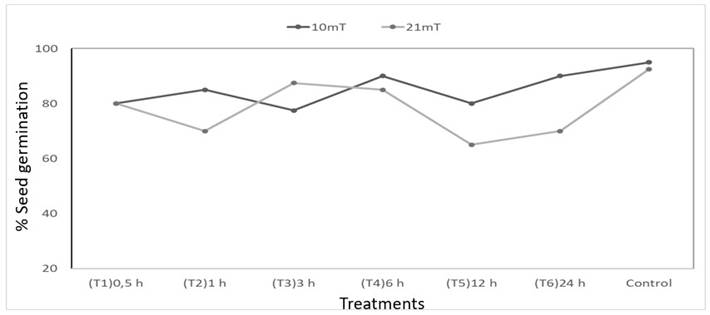INTRODUCTION
In the context of seed technology, using physical methods to increase crop yields offers advantages over conventional chemical treatments, since they are eco-friendly, cheap, and non-invasive techniques that improve germination and seedling vigor (Khan et al., 2017; Acuña et al., 2019). Physical treatments can be addressed at multiple levels, from morpho-structural aspects to changes in gene expression and proteins or metabolites accumulation (Macovei et al., 2014; Radhakrishnan, 2018; Zhao et al., 2018). These impact plants depending on factors such as radiation or magnetic field (type, dose, and time of exposure) and to plant features (e.g., species, cultivar, age, ploidy and complexity of the target organ or tissue) (De Micco et al., 2014). Magnetic fields are the most studied physical pretreatments in agricultural seeds, (Efthimiadou et al., 2014). Lately, several publications have presented the impacts of magnetic fields on many biological processes of plants like growth, development, and metabolism (Balakhnina et al., 2015; Sousa et al., 2016; Bose et al., 2018).
Some research showed that treatments with magnetic fields can improve the tolerance of plants to biotic (Sousa et al., 2016) or abiotic stress (Ouhibi et al., 2014) as a result of the activation of their antioxidant response (Bhardwaj et al., 2012). Consequently, magnetic fields treatments have the additional potential of minimizing the adverse effects of drought or diseases on crop productivity (Sousa et al., 2016). As a result, special interest has been devoted to understanding the physiological, biochemical, and molecular mechanisms, underlying the improvement of the growth of plants treated with magnetic fields (Anand et al., 2012). All of these studies have pointed out the need for more research to understand the molecular mechanisms involved in seeds germination, seedling vigor, and plants photosynthetic capacity exposed to magnetic fields (Sousa et al., 2016). Acuña et al. (2019) showed that Lactuca sativa L. seeds were positively and significantly affected in all their quality parameters, which showed that magnetic induction can be used to reverse seminal deterioration processes.
In general, research carried out on various crops like alfalfa, tomato, and onion, has shown the effect of magnetic fields on seeds germination, seedling growth, and plant development (Ćwintal & Dziwulska-Hunek, 2013; Efthimiadou et al., 2014; El Sagan & El Baset, 2015).
Onion seeds (A. cepa) present problems in their storage because their viability decreases rapidly due to their low quality and germination, non-optimal storage conditions such as high temperatures and relative humidity long flowering periods that result in different stages of maturity of the seeds in the umbel. In Colombia, commercial onion planting materials are hybrids that are produced in other latitudes and environmental conditions, and when introduced to the country, they also generate germination and adaptation problems depending on the agroclimatological conditions of the regions where it is grown. For this reason, research has been carried out for many years to improve seeds germination and to extend their lifespan (Kubisz et al., 2012; El Sagan and Baset, 2015). Kubisz et al. (2012) found that germination of Octavia and Eureka onion cultivars improved from 4,6 to 22% when applying a low magnetic field frequency (20mT) for 10, 30, and 60min; however, there were no differences in shoot length and seedlings fresh weight.
Hozayn et al. (2015) evaluated the effect of magnetic fields on germination, seedling growth, and onions cytogenetics; the results showed that the treatment with magnetic fields increased germination and all growth characteristics of the seedlings as compared to the control. In addition, a significant increase in the mitotic activity and the chromosomal aberrations was observed after treatments of 30 min, leading to the conclusion that the use of magnetic fields could improve the germination of onion seeds. Nevertheless, given that magnetic fields affect the development of biological systems, more studies should be conducted to determine their impact on the improvement of agricultural production (Krawiec et al., 2015). This study aimed to investigate the effects of static magnetic field treatments on onion (Allium cepa) germination and early seedling growth under laboratory conditions.
MATERIALS AND METHODS
Yellow Granex PRR hybrid A. cepa seeds were subjected to two non-uniform magnetic fields: 10 and 21mT. For each magnetic field intensity, 5 exposure times (0.5, 3, 6, 12 and 24h) were used, for a total of 10 treatments. A control (C) was used for each exposure field. For the development of the research, a 10mT magnetic field magnet made of low-intensity ceramic material with an internal diameter of 1.8cm, an external diameter of 3cm, and a height of 0.5cm, and a 21mT magnetic field magnet made of high-intensity neodymium material with an internal diameter of 1.4cm, an external diameter of 2.1cm, and a height of 0.5cm were used. The magnetic field of the magnets was determined with a teslameter (524 009 MOBILE-CASSY°, Germany, Berlin), which has a triaxial probe to determine the electromagnetic radiation of the two magnets used, indicating that the greatest magnetic influence was at the center of the magnets, taking into account that the shape of the magnets is a ring (30) (Figure 1).
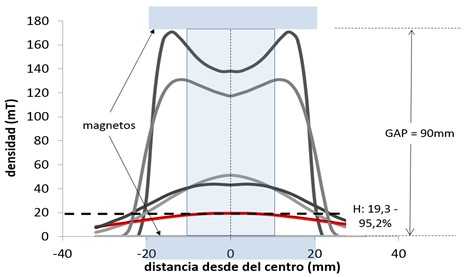
Figure 1 Determination of homogeneity of the magnetic field. The figure shows different magnetic densities according to the height of the measurement plane and their deviation from the magnet´s center (Figure adapted from Acuña et al., 2019).
The seeds used for the tests were Yellow Granex PRR hybrid onion, with a germination percentage of 85% and a moisture content of 12%. Five hundred twenty seeds were used, 240 per magnetic intensity (10 and 21mT) plus 40 seeds as the control. The magnetic treatments involved placing the seeds inside the magnet in Petri dishes located on the north face; consecutively, the seeds were placed and spread out in Petri dishes with sterile and distilled water, distributing 100 seeds per box in four repetitions per treatment. When the seeds germinated, they were planted in Canadian peat at a depth of 0.5cm in a greenhouse. The hook stage appearance (cotyledon in the form of the hook), according to the BBCH coding the phenological stages of bulbous plants, was taken as a germination index.
The germination tests were carried out at room temperature (average temperature of 15°C, relative humidity 89%, photoperiod 6h/day) in the greenhouse. The Canadian peat substrate was moistened daily with 10ml of sterile and distilled water for each repetition. After 6h, the seedlings were removed from the Petri dishes, and seedlings’ height was measured from the leaf apex to the root; subsequently, they were weighed on a 0.01g precision ADAM° PGW 2502 scale.
The test was adjusted to a two-factor randomized complete block design, two magnetic field strengths (10 and 21mT), and five exposure times (0.5, 3, 6, 12, and 24h). The 12 combinations were randomized; each treatment had 4 repetitions and each repetition had 100 experiment units, in addition to the 100 control seeds. As Canadian peat is an inert substrate, it has no direct influence on the results found. The following variables were evaluated:
Germination percentage (%): Number of germinated seeds / Total number of seeds x 100 (El-Kassaby et al., 2008).
The average germination rate was taken as the Average Germination Time (TMG):
TMG = ∑ (t x n) / ∑ n
Where: t is the time in days from sowing, and n is the number of normal seedlings on day "t" (El-Kassaby et al., 2008).
Seedling length (cm) was measured in ten normal seedlings 12 days after planting.
Seedling dry weight (g) was determined in ten normal seedlings 12 days after planting; the seedlings were dried in a hot-air oven at 85°C for 12h to obtain their dry weight (g).
Seedling vigor was calculated following the methodology by Abdul-Baki and Anderson (1973):
Vigor index I: Germination (%) * Seedling length (Root + Shoot)
Vigor index II: Germination (%) * Seedling dry weight (Root + Shoot)
For the data analysis, an analysis of variance (ANOVA), considering the homogeneity of variances between treatments, Shapiro Wilk test was applied for homogeneity of the data, with a confidence level of 95% (P<0.05) using InfoStat Version 2016. The Tukey test was applied to compare mean values.
RESULTS AND DISCUSSION
The results found in this study allowed us to observe some effects on the evaluated physiological variables. However, it is necessary to consider the conditions in which the experiment was developed and other investigations realized in the determination of magnetism on plants in which it is mentioned that is necessary to increase the intensity and the exposure times and could be also considered more uniform fields, a greater number of repetitions, and other experimental designs.
There was no interaction between the main effects evaluated. The results of the germination test obtained in the different treatments showed a similar behavior in the evaluated magnetism concentrations. The germination percentage of the seeds ranged from 77.5% to 95% for the magnetic stimulation with the 10mT magnetic field and from 65% to 92.5% for the 21mT magnetic field (Figure 2).
All of the treatments had a lower germination percentage than the control, with a magnetic intensity of 10mT. The highest germination percentage was coincidentally the same as the control (95%); the lowest germination percentage corresponded to the treatment with three h of exposure with 77.5%, but the difference between the treatments and the control was not significant. Therefore, there was an interaction between the two experimental factors (magnetic field strength and exposure time) (Figure 2).
However, it is imperative to consider that the magnetic treatments consisted of seeds inside the magnet in Petri dishes with sterile and distilled water. It is possible that the fact that the seeds were not dry during the magnetic treatment has influenced the response from onion seeds to the magnetic treatment according to Kubisz et al. (2012) and Sousa et al. (2016), which are relevant effects that must be taken into account when analyzing the results of this study.
The results found in this study are contradictory to those reported by Kubisz et al. (2012) who showed that onion seeds treated with magnetic fields obtained better germination; however, an improvement in germination was not always observed in the results. This limitation of magnetic stimulation had already been reported; for this reason, there was no positive effect from the applied magnetic fields on the germination of onion seeds in studies carried out by Tkalec et al. (2009). This may be because the use of electromagnetic fields in seeds alters the rate of water transport to the seed; it slows down germination, and it is directly dependent on hydration (Prazeres & Medeiros, 2017).
Likewise, the magnetic stimulation of plantain seeds (Plantago media L.), using alternating 50Hz magnetic fields and magnetic induction values of 35, 550m 800, 1150, 1600, and 2000mT, did not affect seed germination, but the activity of antioxidant enzymes increased (Shashurin et al. 2014). On the other hand, mung bean seeds (Vigna radiata) exposed in batches to 22mT static magnetic stimulation for a period of 87 to 100min presented an increase in germination in response to the increase in the constant magnetic flux. The calculated values of mean germination time, germination rate, and water absorption, indicate that the impact of applying static magnetic fields improves germination (Maffei, 2014).
The highest germination and growth rates in lettuce plants were found in the material exposed to a magnetic field of 7mT. Surprisingly, the effects of static magnetic fields on germination and growth increased positively with the increase of osmotic pressure or salt stress, as compared to the respective controls (Cakmak et al., 2010). Similar behavior was observed in the onion seeds stimulated with 10mT for periods of 1, 6, 12 and 24h, with the control achieving a higher germination percentage than the seeds stimulated with the 21mT magnet.
Figure 3 shows the fresh weight of the Yellow Granex PRR hybrid onion seeds that were magnetically stimulated with the 10mT magnet, in which no significant differences were found between the treatments and the control. The treatments of half an hour and 3h obtained a weight of 0.1g; the seeds exposed to the magnet for 1 and 12h achieved 0.09g, and those stimulated for 6 and 24h reached a fresh weight of 0.08g. The control obtained the same fresh weight as the last two treatments.
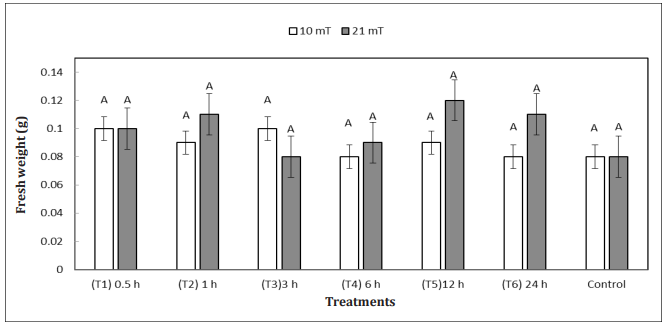
Figure 3 Effect of static magnetic field treatments, on fresh onion weight under laboratory conditions. Different letters in bars show significant differences (P<0.05) according to the Tukey test. Bars represent the average standard error of means.
Acuña et al. (2019) evaluated the effects of the application of uniform magnetic fields on the viability and vigor of previously aged lettuce seeds (24, 48 and 72h, 100% RH, 35°C) at doses of 0, 6,4, and 25,5KJm-3s (Kilo Julios per m3); it was found that the maximum germination, average germination time, and vigor were positively affected by the magnetism doses applied.
For the seeds exposed to 21mT, the fresh weight of the control reached 0.08g, equal to the treatment of 3h of exposure; the seeds exposed for 6h to the magnet achieved a weight of 0.09g. The treatment of half an hour achieved 0.1g, while the treatments with 1 and 24h acquired 0.11g. The 12h treatment was the highest with 0.12 g (Figure 3).
In the experiments carried out by Kubisz et al. (2012) on onions, they found clear differences in the length of the radicle and fresh weight of the seedlings, with radical hairs longer than the control in seeds exposed to magnetic fields. The seeds treated with the 21mT magnetic field obtained higher fresh weights in the exposure times of 1, 6, 12, and 24h, compared to those treated with the 10mT magnetic field. Similar results have been reported in other plant species such as alfalfa, rice, corn, lettuce, and barley (Ćwintal et al., 2013; Mousavizadeh et al., 2013; Karimi et al., 2017; Martínez et al., 2017; Acuña et al., 2019).
Figure 4 shows the behavior of the dry weight after magnetic stimulation; no significant differences were found. The greatest weight was obtained with the control group using 10mT (0.034g), followed by the seeds exposed for half an hour (0.032g). There was a minimal difference between the 6h period (0,022g) and the 1h treatment (0.021g). The seeds exposed for one day to the magnet obtained 0.015g, while those exposed for 3h reached 0.013g; the seeds in the 12h treatment had a dry weight of 0.01g.
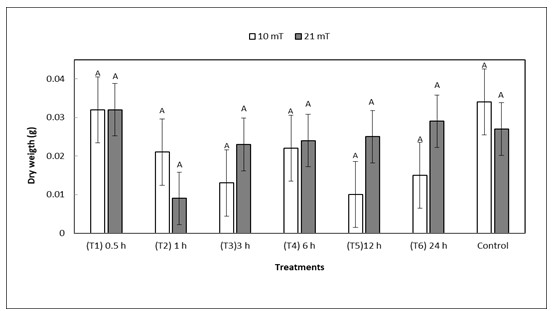
Figure 4 Effect of static magnetic field treatments on dry onion weight. Different letters in bars show significant differences (P<0.05) according to the Tukey test. Bars represent the average standard error of means.
In magnetically stimulated seeds with an intensity of 10 mT, the length of the seedlings in the control was 12 cm during a period of 0.5h and 24h. Seeds exposed for 1h reached the highest length (15cm), followed by the 6h period with 13cm, and the 12h period with 9.5cm. The statistical analysis showed significant differences for this variable (Figure 5).
Figure 5 shows that the length of the seedlings, stimulated to 21mT, had significant differences according to the statistical analysis; the longest length was 13cm, found in the periods of 1h, 3h, and control. The treatments of half an hour and 24h achieved 12cm; the period of 6h reached 11.5cm, and the 12h period obtained 11cm. A small difference was observed in this magnetic intensity.
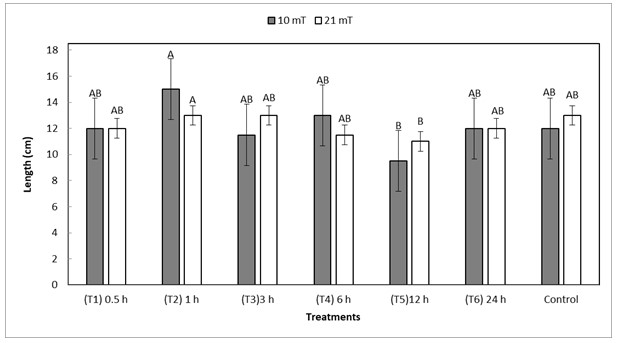
Figure 5 Effect of static magnetic field treatments on onion seedling length under laboratory conditions. Different letters in bars show significant differences (P<0.05) according to the Tukey test. Bars represent the average standard error of means.
Kireva & Mihov (2018) studied the effect of magnetic fields on the productivity of onion and tomato seeds grown by drip irrigation and irrigation regime, finding that the magnetic treatment affected the growth and productivity of the two crops under the two irrigation systems. Tomato increased its yield by 22%, and onion did by 28%. In addition, the treated seeds increased the weight of the fruit by 13% for tomatoes and 26% for onions.
Recently, many authors have reported that the magnetic field affects seed germination, seedling growth, reproduction and growth of meristematic cells, and the amount of chlorophyll (Hozayn et al., 2014; Acuña et al., 2019). The magnetic field positively affects photochemical activity, respiration rate, and enzymatic activity (Hozayn et al., 2015; Baghel et al., 2017). The effect of the magnetic field on seed germination and seedling growth has been proposed by some researchers, including different theories of biochemical and physiological processes. The theory of ionic properties is one of the mechanisms that could explain, the magnetic field's ability to influence the structures of cell membranes, since it produces an increase in ions transport in ion channels, and the density in ionic currents through the cell membrane. As a result, the magnetic field affects the ability of cellular tissues to absorb water and magnetic energy within the cell, and therefore, produces biological changes in organisms (Matwijczuk, 2012).
Some authors have reported another possible theory related to the activity of some enzymes in magnetically exposed seeds that leads to greater germination and seedling growth. Samani et al. (2013) observed an increase in the germination of cumin seeds treated with magnetic fields due to an increase in the activity of three enzymes: amylase, dehydrogenase, and protease. On the other hand, Zlotopolski (2017) showed that the magnetic treatment reduced the use of irrigation water without a negative impact on yield, photosynthesis, and nutrient uptake in lettuce.
All the previous results and those obtained in this study can explain the properties that electromagnetism confers to plants since electricity is a physical phenomenon whose origin is electric charges and whose energy is manifested in mechanical, thermal, light, and chemical phenomena. These properties, together with magnetism, can positively or negatively affect the physiological development of plants (Lorigooini et al., 2017; Zlotopolski, 2017; Acuña et al., 2019).
Investigations carried out using magnetic fields in seeds of different species have shown results that can positively or negatively influence different processes of the plant such as germination. They have also shown that it is important to consider the intensity and times of magnetic exposure used since high levels can generate genetic damage.
Considering a non-uniform magnetic field, and according to other investigations, it was observed that the low-intensity magnetic fields did not generate significant differences in the physiological variables such as germination, dry weight, fresh weight, except for the length variable.
According to the results of this research, it is advisable to continue looking for responses to different magnetic intensities with stationary magnetic fields at different exposure times to improve production systems.













